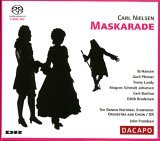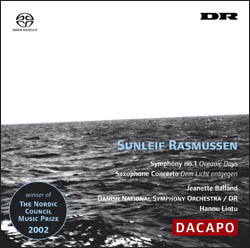| Record companies, artists and publicists are invited to submit CDs to be considered for review. Send to: Jerry Bowles, Editor, Sequenza 21, 340 W. 57th Street, 12B, New York, NY 10019 |
Latest Posts
Ernst Pepping and Allan Pettersson: Moral Dilemmas in Symphonic Music
"The numbers all go to eleven. Look, right across the board, eleven, eleven, eleven and... "
Tell the Birds
Soundtrack to an Apocalypse
Feast Your Ears: New Music for Piano
Gone For Foreign
Fred Lerdahl: Time After Time
Nothing Sacred
Two From Wayne Horvitz
Two Fresh Cantaloupes
Record companies, artists and publicists are invited to submit CDs to be considered for our Editor's Pick's of the month. Send to: Jerry Bowles, Editor, Sequenza 21, 340 W. 57th Street, 12B, New York, NY 10019



|
Archives
Saturday, December 18, 2004
Saturday, December 25, 2004
Friday, December 31, 2004
Wednesday, January 05, 2005
Monday, January 10, 2005
Thursday, January 13, 2005
Thursday, January 20, 2005
Sunday, January 23, 2005
Monday, January 24, 2005
Saturday, January 29, 2005
Wednesday, February 02, 2005
Thursday, February 03, 2005
Monday, February 07, 2005
Tuesday, February 08, 2005
Friday, February 11, 2005
Monday, February 14, 2005
Wednesday, February 16, 2005
Tuesday, February 22, 2005
Monday, February 28, 2005
Sunday, March 06, 2005
Monday, March 07, 2005
Wednesday, March 09, 2005
Sunday, March 13, 2005
Friday, March 18, 2005
Monday, March 28, 2005
Saturday, April 02, 2005
Monday, April 11, 2005
Sunday, April 17, 2005
Tuesday, April 19, 2005
Monday, April 25, 2005
Monday, May 02, 2005
Monday, May 09, 2005
Tuesday, May 17, 2005
Tuesday, May 31, 2005
Monday, June 06, 2005
Thursday, June 16, 2005
Sunday, June 19, 2005
Sunday, July 10, 2005
Wednesday, July 13, 2005
Sunday, July 24, 2005
Friday, July 29, 2005
Monday, August 08, 2005
Monday, August 22, 2005
Wednesday, August 24, 2005
Friday, September 16, 2005
Sunday, September 25, 2005
Tuesday, October 04, 2005
Tuesday, October 18, 2005
Monday, October 24, 2005
Tuesday, November 01, 2005
Monday, November 07, 2005
Saturday, November 12, 2005
Wednesday, November 16, 2005
Tuesday, November 29, 2005
Friday, December 16, 2005
Monday, January 09, 2006
Thursday, January 12, 2006
Thursday, January 19, 2006
Tuesday, January 24, 2006
Thursday, February 02, 2006
Monday, February 13, 2006
Wednesday, February 15, 2006
Wednesday, March 01, 2006
Sunday, March 19, 2006
Sunday, March 26, 2006
Friday, March 31, 2006
Sunday, April 09, 2006
Monday, April 10, 2006
Thursday, April 20, 2006
Friday, April 21, 2006
Thursday, May 11, 2006
Thursday, May 18, 2006
Saturday, May 20, 2006
Friday, June 02, 2006
Tuesday, June 06, 2006
Friday, June 16, 2006
Monday, June 19, 2006
Sunday, June 25, 2006
Monday, June 26, 2006
Monday, July 10, 2006
Thursday, July 13, 2006
Thursday, July 20, 2006
Friday, July 21, 2006
Sunday, July 23, 2006
Thursday, August 03, 2006
Wednesday, August 09, 2006

|
|
Monday, May 09, 2005
Northern Lights: Nielsen, Rasmussen, Maxwell Davies
 Maskarade Maskarade
Carl Nielsen
Conductor: John Frandsen
Performer: Ib Hansen, Mogens Schmidt Johansen, et al.
Ensemble: Danish National Symphony Orchestra
Da Capo (Naxos)
Encountering Carl Nielsen's 1906 comic opera, Maskarade, for the first time is a delightful revelationólike discovering that the uncle you always thought was brilliant but a bit of a stiff can do a mean Elvis impersonation. Recorded in 1977 and just reissued on SACD, this is a magnificent performance of a highly-listenable opera that clearly deserves to be much better-known and frequently played.
The plot is the usual silly stuff. Jeronimus (bass) has arranged a marriage between his son Leander (tenor) and his friend Leonard's daughter, Leonora (soprano). But each of them has fallen in love with someone they met the night before at a nightly masked ball and are going through the usual contortions to get out of arranged marriage. When the unmasking occurs the next night...well, I donít want to spoil it for you.
The music of Maskarade is clearly Nielsen, but more Nielsen after a couple of aquavits, than the sober Nielsen of the symphonies. The characteristic harmonies are there but the brass and woodwinds have a lighter, jauntier air which perfectly matches the paper-thin plot. You may have heard the overture before; it is sometimes played in concerts, but you will likely be surprised (or, at least, I was) at how appealing the dance music is throughout. (Wow, Dick, this has a beat and itís fun to dance to.) There is also a haunting love duet in Act II that is the equivalent of Uncle Carl doing a perfect version of ďLoving You.Ē
From a purely musical point of a view, Maskarade is a lovely and neglected little masterpiece. Its ambitions seem pretty much in line with what Leonard Bernstein was going for in Candide many years later but didnít really pull off. The fact that it is sung in Danish is not a problem; you donít need to understand whatís going on to be captivated by the music. In fact, it probably helps that you donít. Nobody ever went to see La Boheme for the plot. Just put it on, crank up the old stereo, and enjoy.
Memo to Metropolitan Opera: Give Die Fledermaus a rest and put this one in the New Yearís Eve rotation.
 Symphony 1/Saxophone Concerto Symphony 1/Saxophone Concerto
Sunleif Rasmussen
Danish National Symphony
Da Capo (Naxos)
Who knew the Faroe Islands were such a hot bed of contemporary musical creativity? Composer Kristian Blak was a pleasant discovery by reviewer Lanier Sammonds a few weeks ago, and now this extraordinary SACD recording of Sunlief Rasmussenís Symphony No. 1 Oceanic Days and Saxophone Concerto Dem Licht entgegen has me googling for clues to the Farosese and their native habitat. As Iím sure you already knew, the Faroe Islands are located in the heart of the Gulf Stream in the North Atlantic at 62į00íN, northwest of Scotland and halfway between Iceland and Norway. The archipelago is composed of 18 islands covering 545.3 sq.miles and is 70 miles long and 47 miles wide, roughly in the shape of an arrowhead. There are 687 miles of coastline and it is impossible for any resident to ever be more than three miles from the ocean.
The basic elements of life are light and darkness endlessly revealing and hiding themselves against the constant, yet always changing, rhythms of the sea. That is is the world that is so magnificently drawn, in trompe líoeil, by Rasmussenís sprawling Symphony No. 1 subtitled ďOceanic Days.Ē The musical framework is a mixture of tonal and atonal; Rasmussenís sea is far rougher and more dangerous than la mer of Debussy or the seas of Frank Bridge and Benjamin Britten. But, it is no less compelling than those sea-based masterpieces.
The Saxophone Concerto has more orchestral contrast, as you would expect from a concerto, but the overarching framework is an indefinable movement from darkness towards the light. The concerto has a constantly ascending musical trajectory, which is reflected by the way the soloist must change in the course of the work from the low baritone saxophone through the tenor and alto to the bright soprano saxophone at the end. Rasmussen may be from a small place but heís clearly a major talent.
 Naxos Quartets Nos. 3 & 4 Naxos Quartets Nos. 3 & 4
Peter Maxwell Davies
Maggini Quartet.
Naxos
Peter Maxwell Daviesí northern kingdom is Orkney, a string of islands at the northernmost reaches of Scotland, and he has remarked on several occasions that finding peace and tranquillity there has been one of the most important events in his life. Certainly, there is a grace and maturity in the series of string quartets he is writing for the Naxos label that suggests a near-great composer making a valient late grab for the gold ring of music immorality. The splendid quartets 1 and 2 were, it appears, mere preambles for more even demanding efforts to come. Nos. 3 and 4 bring the listener to a whole new level of complexity.
Sir Max is famous for his rather flatulent program notes and his suggestion that No. 3 began as an exercise in musical numerology and morphed into a anti-war protest against the invasion of Iraq is entertaining but what No. 3 sounds like is an attempt to see how much contrast it is possible to get from a string quartet using only a musical palette comprised of different shades of grey. The piece suggests Orkney on a dark, wet winter day more than an impassioned cry for humanity. No. 4, one long single movement, is obstensibly based on a painting of Brughel of children playing and it carries about it the kind of sadness and pleasure that older people get from revisiting their early memories. The playing by the Maggini Quartet is astonishing.
posted by Jerry Bowles
8:56 AM
|
|




